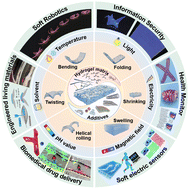3D shape morphing of stimuli-responsive composite hydrogels
Abstract
In nature, plants and animals undergo remodeling to adapt to changes in their surroundings. Stimuli-responsive hydrogels, with their abundant water content and inherent responsiveness to environmental stimuli, serve as ideal candidates for mimicking the morphing behavior of living tissues or organisms. When combined with other materials, stimuli-responsive hydrogels extend their shape morphing abilities, along with corresponding functionalities. This review delves into the fundamentals involved in incorporating stimuli-responsive hydrogel matrices and functional additives, exploring the shape morphing mechanism and fabricating stimuli-responsive composite hydrogels. An exploration of recent advances in stimuli-responsive composite hydrogels suggests their potential applications in diverse fields, including soft robotics, information encryption/decryption, biomedical research, flexible electronics, and engineering living materials. As these innovative materials continue to develop, they hold the promise of revolutionizing daily lives and shaping the future of the biosphere.

- This article is part of the themed collections: Materials Chemistry Frontiers Emerging Investigator Series 2022–2023, 2023 Materials Chemistry Frontiers Review-type Articles and 2023 Materials Chemistry Frontiers HOT articles


 Please wait while we load your content...
Please wait while we load your content...